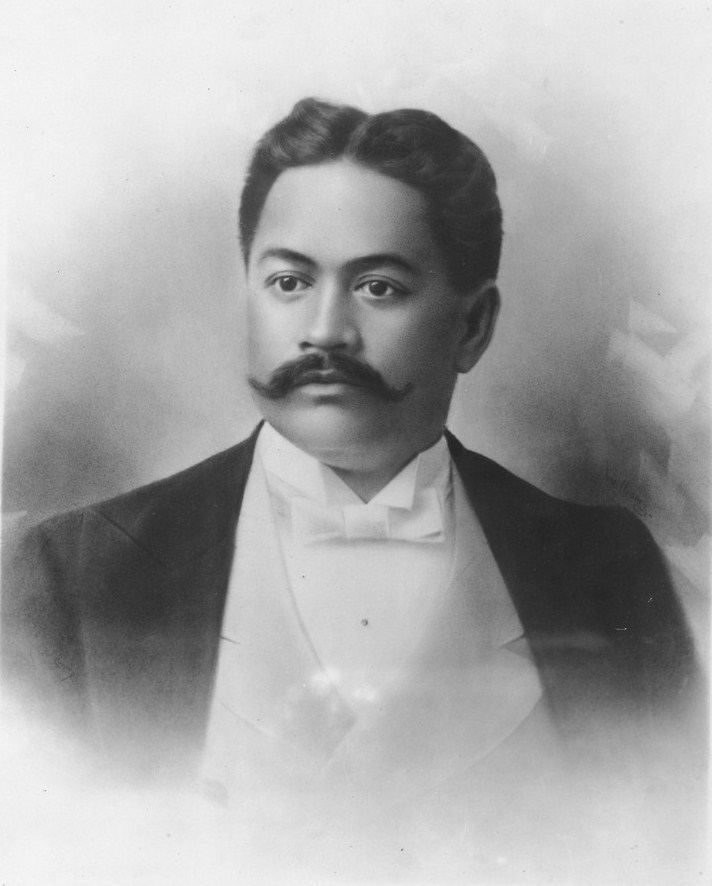Name David Kawananakoa | ||
 | ||
Burial (1908-06-21)June 21, 1908Mauna ʻAla Royal Mausoleum Issue David Kalakaua KawananakoaAbigail Kapiʻolani KawananakoaLydia Liliʻuokalani Kawananakoa House House of KalakauaHouse of Kawananakoa Father David Kahalepouli PiʻikoiKing Kalakaua (hanai) | ||
David Kawānanakoa
David Laʻamea Kahalepouli Kinoiki Kawānanakoa (February 19, 1868 – June 2, 1908) was a prince of the Kingdom of Hawaiʻi and founder of the House of Kawānanakoa. He was in the line of succession to the throne of the Kingdom of Hawaiʻi around the time of the kingdom's overthrow. Kawānanakoa translates as "fearless prophecy" in Hawaiian.
Contents
Life

Kawānanakoa was born February 19, 1868 at Kaʻalaʻa at the mouth of the Pauoa Valley, in Honolulu, on the old homestead of his aunt Queen Kapiʻolani. David was the first child of his father High Chief David Kahalepouli Piʻikoi from Kauaʻi island, and his mother Victoria Kūhiō Kinoiki Kekaulike, a noble from the district of Hilo who was later the royal governor of the island of Hawaiiʻi. His younger brothers were Edward Abnel Keliʻiahonui (1869–1887) and Jonah Kūhiō Kalanianaʻole (1871–1922). David's family name Kawānanakoa was developed personally for him, and his own descendants have taken it for their family and name of their monarchical Royal house.
He was granted the title of Prince and style of His Royal Highness in 1883 by King Kalākaua. He was declared the third heir (after then princess Liliʻuokalani and princess Kaʻiulani) to the throne of the Kingdom of Hawaiʻi to avoid problematic royal elections. His mother was the sister of Queen Kapiʻolani, consort to Kalākaua. He was also King Kalākaua's first cousin; these relations gave prince Kawānanakoa his position in the succession order. In 1885 he was sent by the Hawaiian government to attend Saint Matthew's School, a private Episcopal military school in San Mateo, California. His two brothers would also attend.
While attending school in San Mateo, David and his brothers would travel south to the Pacific seashore at Santa Cruz. The brothers demonstrated the Hawaiian sport of board surfing to the locals, becoming the first California surfers in 1885.
On August 31, 1891, Queen Liliʻuokalani appointed him a member of her Privy Council. In 1893 the Hawaiian Kingdom was overthrown, Kawānanakoa became a supporter of the Royalist resistance and after the failed 1895 Counter-Revolution he was arrested for treason but due to lack of evidence he was released. In 1898 he announced his engagement to Kaʻiulani, but she died in 1899 before the wedding could take place.
Kawānanakoa was one of five founders of the Democratic Party of Hawaii. He attended the 1900 Democratic National Convention in Kansas City, Missouri and was the first royal to attend a national presidential nominating convention, where he was successful in gaining affiliation between his party and the Democratic Party in a party vote at the convention to incorporate Hawaii. He voted to break a tie about importing a plank into the convention platform regarding free silver.
In 1902, Kawānanakoa married Abigail Wahiʻikaʻahuʻula Campbell who assumed the title of princess. Their children were Princess Abigail Kapiʻolani (1903–1961), Prince Edward David Kalākaua (1904–1953), and Princess Lydia Liliʻuokalani (1905–1969).
Kawānanakoa converted to Roman Catholicism in 1907, no doubt through the urging of his wife. He died of pneumonia June 2, 1908 in San Francisco. After an elaborate funeral and parade, he was buried in the Royal Mausoleum of Hawaii.
